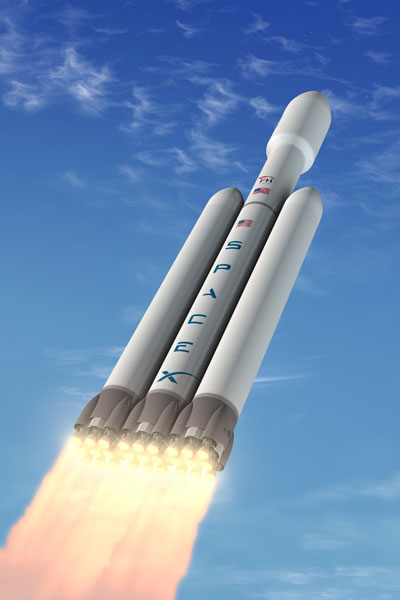 |
| Forum: | Commercial Space - Military Space |
| Topic: | SpaceX Falcon Heavy heavy-lift launch vehicle |
|
| Want to register?
|
If you have previously registered, but forgotten your password, click here.
"Falcon Heavy will arrive at our Vandenberg, California, launch complex by the end of next year, with liftoff to follow soon thereafter. First launch from our Cape Canaveral launch complex is planned for late 2013 or 2014."
Musk added that with the ability to carry satellites or interplanetary spacecraft weighing over 53 metric tons or 117,000 pounds to orbit, Falcon Heavy will have more than twice the performance of the Space Shuttle or Delta IV Heavy, the next most powerful vehicle, which is operated by United Launch Alliance, a Boeing-Lockheed Martin joint venture.
53 metric tons is more than the maximum take-off weight of a fully-loaded Boeing 737-200 with 136 passengers. In other words, Falcon Heavy can deliver the equivalent of an entire commercial airplane full of passengers, crew, luggage and fuel all the way to orbit. Falcon Heavy's first stage will be made up of three nine-engine cores, which are used as the first stage of the SpaceX Falcon 9 launch vehicle. It will be powered by SpaceX's upgraded Merlin engines currently being tested at the SpaceX rocket development facility in McGregor, Texas. Falcon Heavy will generate 3.8 million pounds of thrust at liftoff. This is the equivalent to the thrust of fifteen Boeing 747s taking off at the same time.
Above all, Falcon Heavy has been designed for extreme reliability. Unique safety features of the Falcon 9 are preserved, such as the ability to complete its mission even if multiple engines fail. Like a commercial airliner, each engine is surrounded by a protective shell that contains a worst case situation like fire or a chamber rupture, preventing it from affecting other engines or the vehicle itself.
Anticipating potential astronaut transport needs, Falcon Heavy is also designed to meet NASA human rating standards, unlike other satellite launch vehicles. For example, this means designing to higher structural safety margins of 40% above flight loads, rather than the 25% level of other rockets, and triple redundant avionics.
Falcon Heavy will be the first rocket in history to do propellant cross-feed from the side boosters to the center core, thus leaving the center core with most of its propellant after the side boosters separate. The net effect is that Falcon Heavy achieves performance comparable to a three stage rocket, even though only the upper stage is airlit, further improving both payload performance and reliability. Crossfeed is not required for missions below 100,000 lbs, and can be turned off if desired.
Despite being designed to higher structural margins than other rockets, the side booster stages will have a mass ratio (full of propellant vs empty) above 30, better than any vehicle of any kind in history.  Falcon Heavy, with more than twice the payload, but less than one third the cost of a Delta IV Heavy, will provide much needed relief to government and commercial budgets. In fact, Falcon Heavy at approximately $1,000 per pound to orbit, sets a new world record in affordable spaceflight.
This year, even as the Department of Defense budget was cut, the EELV launch program, which includes the Delta IV, still saw a thirty percent increase.
The 2012 budget for four Air Force launches is $1.74B, which is an average of $435M per launch. Falcon 9 is offered on the commercial market for $50-60M and Falcon Heavy is offered for $80-$125M. Unlike our competitors, this price includes all non-recurring development costs and on-orbit delivery of an agreed upon mission. For government missions, NASA has added mission assurance and additional services to the Falcon 9 for less than $20M. Vehicle Overview
| Mass to Orbit (200 km, 28.5 deg): | 53 metric tons (117,000 lbs) | | Length: | 69.2 meters (227 ft) | | Max Stage Width: | 5.2 m (17 ft) | | Total Width: | 11.6 meters (38 ft) | | Weight at Liftoff: | 1,400 metric tons or 3.1 million lbs | | Thrust on Liftoff: | 1,700 metric tons or 3.8 million lbs |
Please note that Falcon Heavy should not be confused with the super heavy lift rocket program being debated by the U.S. Congress. That vehicle is authorized to carry between 70-130 metric tons to orbit. SpaceX agrees with the need to develop a vehicle of that class as the best way to conduct a large number of human missions to Mars. |
| Robert Pearlman | SpaceX release Intelsat Signs First Commercial Falcon Heavy Launch Agreement with SpaceXAdvanced Vehicle Provides Expanded Options for Operator of the World's Largest Satellite Fleet Today, Intelsat, the world's leading provider of satellite services, and Space Exploration Technologies (SpaceX), the world's fastest growing space launch company, announced the first commercial contract for the Falcon Heavy rocket.
"SpaceX is very proud to have the confidence of Intelsat, a leader in the satellite communication services industry," said Elon Musk, SpaceX CEO and Chief Designer. "The Falcon Heavy has more than twice the power of the next largest rocket in the world. With this new vehicle, SpaceX launch systems now cover the entire spectrum of the launch needs for commercial, civil and national security customers."
"Timely access to space is an essential element of our commercial supply chain," said Thierry Guillemin, Intelsat CTO. "As a global leader in the satellite sector, our support of successful new entrants to the commercial launch industry reduces risk in our business model. Intelsat has exacting technical standards and requirements for proven flight heritage for our satellite launches. We will work closely with SpaceX as the Falcon Heavy completes rigorous flight tests prior to our future launch requirements."
This is the first commercial contract for SpaceX's Falcon Heavy launch vehicle. Under the agreement, an Intelsat satellite will be launched into geosynchronous transfer orbit (GTO). |


